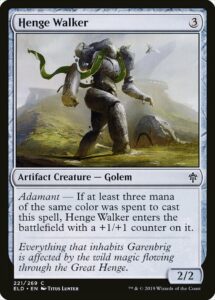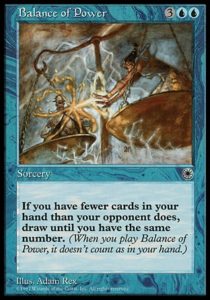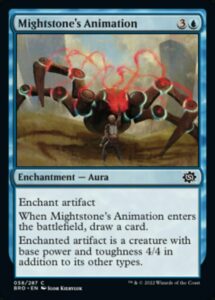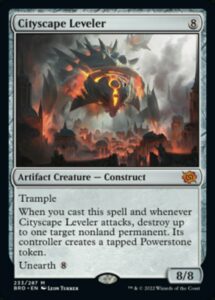The Brothers’ War has been out for over a week, which means there’s been just enough time to get a feel for it (and maybe binge twenty or so drafts between Arena and tabletop events). For some people, this is the time they’re perusing 17Lands for data about individual cards and archetypes. Me, I like to try out a bunch of different archetypes and get a sense of what seems to be underdrafted online. I pay attention to what works for me, what works for my opponents, and the cards that seem to underperform.
Mine’s a much more subjective approach, since I both can’t compare to the wealth of data being generated by millions of online games, nor am I an expert in parsing it. However, I find this approach helpful and easy to share with my friends and readers—plus, by avoiding early raw data, I avoid the easy error of making decisions about a format before it’s settled (by parsing data as a non-expert). So, with that said, here’s how the format looks so far.

It’s an Adamant world
The Brother’s War is defined by its large quantity of powerful, generic mana artifacts. That could be a foundation for being ambitious with your colors, but Prototype makes it so you really need colors early on. Evolving Wilds and Energy Refractor are better at enabling splashes than the greedy 3+ color decks many players embraced in Dominaria United. Add in that many players will be relying on generic mana-producing Powerstones for mana as well as the powerful rewards for being monocolor like Corrupt and Flow of Knowledge. All that puts pressure on your mana base and rewards you for being monocolor (sometimes with a small splash).
The format reminds me a fair bit of Throne of Eldraine Limited. You don’t have to be a monocolor deck, but many of the two color pairs underperform, many of the colorless cards overperform, and there are major rewards for being a single color. In Throne of Eldraine, you could work hard to turn your Improbable Alliance into a very, very slow Lingering Souls, or you could simply cave your opponent’s face in with Garenbrig Paladin or the free counters from an Idyllic Grange while never having color problems and skimping on a land.
It’s definitely easier to splash in The Brother’s War than it was in Throne of Eldraine, but many of my best decks have been single color (occasionally with a splash) and they’ve generally beaten all the multicolor decks they faced.

Color performance
So far, I’ve been most impressed by blue and white, and least impressed by red and green. That doesn’t mean those are the best or worst colors, just that in the first week, I tend to win with and lose to the former and do the opposite with the others. Red has solid commons like Excavation Explosion and Mishra’s Juggernaut, but it’s done better work for me as a support or splash color rather than a primary one. Green seems to have awkward spots with its curve (besides the excellent Argothian Opportunist); it’s trying to be both an aggro deck and a ramp deck, but its aggressive creatures are easily dispatched and it’s fighting for ramp with every other color thanks to Prototype.
Of the two color archetypes, black-red has overperformed: sacrifice archetypes are great when there’s plenty of fodder even when you don’t have Sibling Rivalry. White-blue and green-white have been awkward: they’re both reliant on drawing specific combinations of cards in the right order and can be very vulnerable to disruption. UB, RG, WB, UR, BG, and GU are all sort of there—they’re mini-archetypes that don’t provide too much synergy, so they’ve felt to me like lesser versions of monocolor decks where they couldn’t get away with just splashing a Battery Bearer or Third Path Iconoclast. And then there’s red-white, which can be impressively strong thanks to Whirling Strike, but also suffers when it has more mana issues than the monocolor big mana decks it’s trying to prey upon.
We’ll see how the format shakes out over time or how far from the average experience I’ve had. I wouldn’t be surprised if aggro decks get worse over time (as people learn how to build their decks to beat them) or eventually get better (as people prebuild their decks for big mana haymaker mirrors, as happened in Dominaria United with Domain decks). I also look forward to people either figuring out how to make more of the two color combinations work or abandoning them and competing more for monocolor decks.

The MVP
No common has overperformed for me more than Mightstone’s Animation. Four power is a lot in The Brother’s War, and it’s facile to animate and swing on turn four with a Powerstone, Energy Refractor, or even an Ichor Wellspring, Chromatic Star, or Ornithopter. A 4/4 eats most attackers on defense, and races many aggressive starts well.
Stern Lesson into Mightstone’s Animation is easy to do and hard for most decks to profitably stop or race. And yet I’m somehow able to routinely get 3+ copies of Mightstone’s Animation—either I’m getting consistently lucky, or people are sleeping on one of the best commons of the set.
There’s even weird tricks you can do with it, like knock off a Blackblade Reforged by animating it (creatures can’t be attached to other creatures (unless they have Reconfigure) or downgrade an opponent’s 10/10 Rust Goliath into a 4/4. The card has amazing flexibility for one that’s already a powerful effect and also draws you a card. It’s not hard to build around (the format already rewards you for having a high density of 1 and 2 mana artifacts) and wins games by itself.

Beware of bombs
There are plenty of powerful rares in The Brother’s War. Many of them are colorless or splashable, which drastically increases the likelihood of them seeing play. There’s also the retro frame artifact in each pack—while most of them are relatively replaceable cantrips or Commander-focused cards, there are also powerhouses like Precursor Golem and Wurmcoil Engine.
Now, that’s not to say the format is all about resolving a bomb and riding it to victory—there are tools for dealing with—but you should have a plan for when your opponent resolves a game-changing artifact. It’s likely to happen, so you may need to be a stingier with your removal, or a bit more careful with that counterspell once your opponent starts hitting their late game land drops. Dominaria United and Streets of New Capenna were less defined by the rare slot, and it’s a nice change of pace to see it have a more dramatic impact on the texture of each game.
And with that, we’ll close for the day. I’ve been really enjoying The Brother’s War for how different it feels and how fun I find the card interaction—even if I don’t love how confusing some of the cards can be, or how awkward Powerstones are worded. But those are thoughts for another time. For now, I hope you’re having as much fun playing with BRO as am, and I look forward to seeing how the format evolves!
Zachary Barash (he/him) is a New York City-based game designer and the last commissioner of Team Draft League. He designs for Kingdom Death: Monster, has a Game Design MFA from the NYU Game Center, and does freelance game design. When the stars align, he streams Magic (but the stars align way less often than he’d like).

